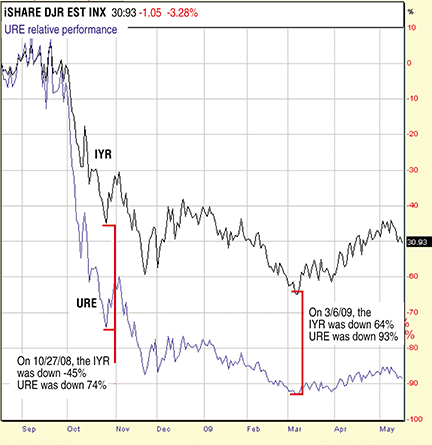TRADING TECHNIQUES
What Are They, Anyway?
Are Leveraged Sector Etfs For You?
Find out if you can include these products in your list of tradables.
In 1992, the American Stock Exchange (Amex) petitioned the Securities and Exchange Commission (Sec) to create a standalone index-based exchange traded fund (Etf). Upon Sec approval, Amex rolled out the first Etf product: the S&P Depository Receipts Trust Series 1, or Spdrs (Spy). It gained widespread acceptance as a way to diversify (reduce risk) and mimic the broader market of the 500 largest capitalized stocks on the New York Stock Exchange (Nyse).
Others followed, with the Dia, which tracks the Dow Jones Industrial Average, and the Qqq (later to become the Qqqq), which tracks the 100 largest-capitalization Nasdaq stocks. In the past couple of years, the market has seen a plethora of leveraged Etf products. What are these and do they have a place in your portfolio?
What is a leveraged ETF?
Typically, a leveraged Etf is an exchange traded fund based upon an already familiar index but provides investors with some extra juice — leverage. The goal of the leveraged Etf is to increase the returns of the underlying index for a given time frame (each day) by using financial derivatives (like options, swaps, and index futures) to provide a higher-octane return than the nonleveraged Etf. In layman’s terms, they take every dollar you invest when buying the Etf and then borrow another dollar against it to create a leveraged Etf. The leverage occurs on a daily basis and that’s the crucial difference between nonleveraged and leveraged Etf products.
In Figure 1 you see a chart of one such paired product. This is the iShares Dow Jones US Real Estate Index Fund (Iyr) and its leveraged counterpart, the ProShares Ultra Real Estate (Ure). Since they both are based upon the Dow Jones US Real Estate Index, you would think that the chart would show the Iyr as a flatter line (since it carries no leverage) and the Ure would roughly double that line both on the upside and the downside (since it is a 2:1 leverage instrument).

Figure 1: iShares dow jones us real estate index fund (iyr) and proshares ultra real estate (ure). Both these are based on the Dow Jones US Real Estate Index. You would expect the IYR to be a flatter line since it doesn’t carry leverage and URE would be about double the IYR since it is 2:1 leverage instrument. But it doesn’t look that way.
What we find, however, is not an exact 2:1 ratio. Note the two points shown on the chart where the ratio is clearly not at 2:1. In fact, most of the chart is not a 2:1 ratio that you study, and the exact ratio varies over time.